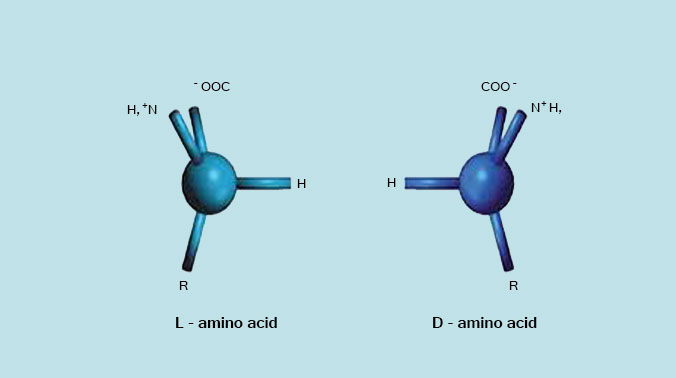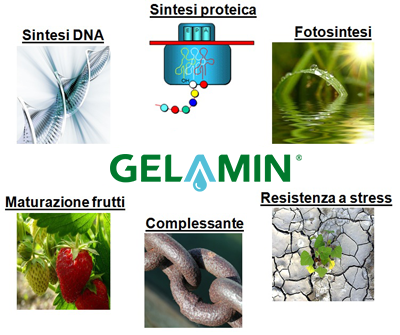During the enzymatic hydrolysis process, protein fractions of variable length (polypeptides, peptides, and free aminoacids) are formed: the molecular size of peptides can be variable, depending on the intensity of hydrolysis, and ranging between a few hundred and several thousand daltons (Da).

The presence of these fractions with different molecular weight ensures both the nutritional and the biostimulating action of the GELAMIN® matrix.
In particular, the bio-stimulating properties of protein hydrolysates are primarily derived from free aminoacid: the aminoacid content is therefore an important parameter for the agro-nomic evaluation of protein hydrolysates.
According to several authors, in fact, aminoacids, especially in free form, would affect the physiological activities of the plant and in particular:
- chlorophyll photosynthesis, since glycine is a constituent of chlorophyll;
- protein synthesis, since glutamic acid, glutamine, aspartic acid and asparagine are the starting amino-acids of protein synthesis;
- a complexing action, since aspartic acid, glutamic acid and glycine are capable of forming chelates with nutrients and molecules of different nature;
- lignification, since phenylalanine is one of the precursors for lignin biosynthesis;
- resistance to abiotic stresses, since proline (and hydroxyproline) accumulates in the cytoplasm as a result of water and osmotic stress; alanine (and γ-aminobutyrate) does in the case of anaerobic stress; glutathione (a compound derived from the aminoacid cysteine) does in the case of presence of heavy metals and oxidative stress, and; polyamines derived from arginine do in the case of potassium shor-tage and hydric or osmotic stresses;
- a hormone-like activity given that several aminoacids are metabolic precursors of phytohormones (for ex., tryptophan is a precursor of indoleacetic acid; methionine is of ethylene, and; arginine is of polyamines);
- the fruit ripening processes, since alanine, isoleucine, leucine and valine are precursors of aromas; phenylalanine is a precursor of color, and; alanine, arginine, glycine and proline are precursors of flavor.

The aminoacids in the gelatin GELAMIN® are mainly in the L form (levorotatory), which is biologically active and recognized by plants.
► The levorotatory aminoacids maintain their biological activity since the use of specific enzymes and low temperatures during the enzymatic hydrolysis process allows reducing the racemization phenomena of free aminoacids, which are typical instead of chemical or high temperature hydrolysis.
Racemization is a natural phenomenon leading to the formation of dextrorotatory (in the D form) and levorotatory (in the L form) aminoacids from a mixture that only contains levorotatory aminoacids.
► Racemization proceeds very slowly at room temperature, while it is considerably accelerated at high tem-peratures: this is one of the reasons why dextrorotatory aminoacids are virtually absent in nature, and it has been proven that they can also have negative or even toxic effects on living organisms.
